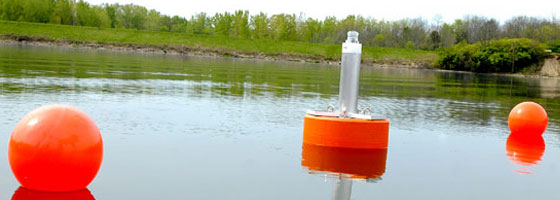Ford Lake buoy systems assist algae management plan

Summary
Located along the Huron River near Detroit, Ford Lake is one of the largest impoundments on the Huron and has been used for hydroelectric power purposes since 1932. The Ford Lake Dam was originally constructed by Henry Ford, who was an expert on hydroelectric power generation. The dam is currently owned and operated by Charter Township of Ypsilanti, and it is still used for generating and selling electricity.
During late summer months, Ford Lake experiences massive algae growth, causing localized fish kills and foul odor. As a result, the lake has been the site of a research study sponsored by the US EPA (2003-2006) and also by the USDA since 2006. The study, led by Professor John Lehman of the University of Michigan, probes the causes and possible corrective measures for the nuisance algal blooms that plague Ford Lake.
Researchers have developed a management plan that they’ll test through lake experiments from 2006 to 2009. To complement and help automate these experiments, the Charter Township of Ypsilanti recently deployed two real-time dissolved oxygen monitoring lake buoy systems along with a multi-parameter weather station.
Lake Buoy System Description
YSI 600OMS V2 optical monitoring sondes with ROX Optical Dissolved Oxygen sensors were chosen to measure DO levels at five-minute sampling intervals. The ROX Optical DO sensor features a self-cleaning wiper that is ideal for long-term deployments. A NexSens T-Node water temperature string collects data from these sondes, along with other T-Node temperature nodes, to obtain a complete vertical water quality profile.
University of Michigan researchers also chose to integrate existing Turner Cyclops-7 and SCUFA submersible fluorometers into the system for measuring chlorophyll, turbidity, and phycocyanin (blue-green pigment). NexSens Technology created a connectorized sensor cable with a UW Underwater Connector, allowing plug-and-play integration to the buoy.
 Housed within each buoy, a NexSens submersible radio telemetry data logger collects data from the instruments. Data transmits via wireless spread-spectrum radio telemetry to the hydroelectric plant’s rooftop. Also mounted on the roof is a Vaisala WXT510 multi-parameter weather sensor. This highly accurate sensor features no moving parts and simultaneously measures wind speed and direction, liquid precipitation, air temperature, relative humidity, and barometric pressure.
Housed within each buoy, a NexSens submersible radio telemetry data logger collects data from the instruments. Data transmits via wireless spread-spectrum radio telemetry to the hydroelectric plant’s rooftop. Also mounted on the roof is a Vaisala WXT510 multi-parameter weather sensor. This highly accurate sensor features no moving parts and simultaneously measures wind speed and direction, liquid precipitation, air temperature, relative humidity, and barometric pressure.
By making this data available to all interested parties via the NexSens WQData web datacenter, researchers can investigate the interactions of weather conditions and river water quality in real time. Researchers are also using this real-time data to develop complex computer animations that show the changing temperature, oxygen, and pigments in 3D. Moving forward, Dr. Lehman and his group hope to develop new theories that can guide future lake management efforts both on the Huron River and nationwide.


 The multi-point dissolved oxygen monitoring buoys are deployed at two locations near the dam, both in Ford Lake and downstream of the Huron River. Researchers selected the NexSens MB-300 Monitoring Buoy, a 30-inch diameter, polymer-coated, foam-hull buoy with 300 lb. buoyancy. This compact buoy is easy to deploy and ideal for supporting monitoring instruments in small reservoirs, lakes, rivers, streams, and protected coastal waters.
The multi-point dissolved oxygen monitoring buoys are deployed at two locations near the dam, both in Ford Lake and downstream of the Huron River. Researchers selected the NexSens MB-300 Monitoring Buoy, a 30-inch diameter, polymer-coated, foam-hull buoy with 300 lb. buoyancy. This compact buoy is easy to deploy and ideal for supporting monitoring instruments in small reservoirs, lakes, rivers, streams, and protected coastal waters.


0 comments